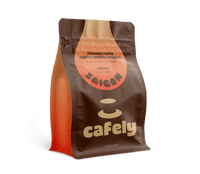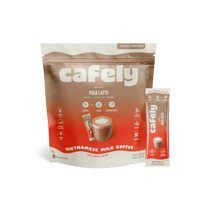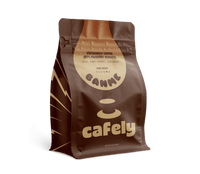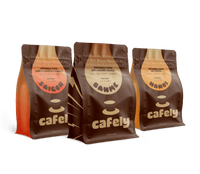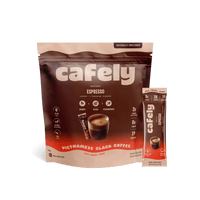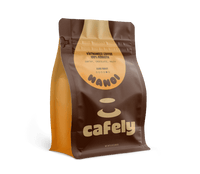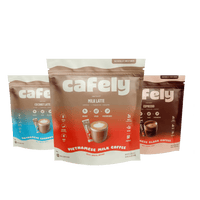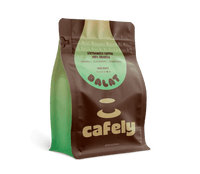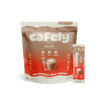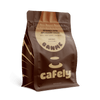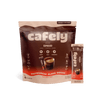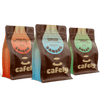Living with any ongoing condition can be tricky, but it shouldn’t mean that you have to go without those things that bring you joy. For coffee nerds like us, this means that we certainly shouldn’t go without that first cup in the morning.
If you have ulcers but still have a love for coffee, it’s important to select a brew that won’t worsen your symptoms.
In this guide, you’ll learn about the best low-acid coffee for stomach ulcers, how to brew stomach-friendly coffee and everything else you need to know.
What’s the Best Coffee for Ulcers?
As a general rule, people with stomach ulcers should avoid or heavily restrict their coffee intake. However, drinking certain types of coffee in moderation may be okay. If you want to drink coffee with stomach ulcers, the best coffee should have low acidity and be cold brewed.
Here’s what to look for when searching for the best coffee for ulcers:
- Robusta Coffee — The best coffee for people with stomach ulcers is robusta. 100% robusta coffee is less acidic than arabica coffee.
- Cold Brew Coffee — The best way to make coffee if you have ulcers is cold brewing. The process of extracting coffee using cold water creates a brew that may be up to two-thirds less acidic than hot-brewed coffee.
- Dark Roast — Dark roast coffee may be better than light and medium roasts for stomach ulcers. A prolonged roasting process reduces the amount of chlorogenic acids in the beans — creating a less acidic coffee.
If you want to drink coffee with stomach ulcers do so in moderation. Opt for a dark roast robusta or a robusta-dominant blend. Cold brew the coffee to create a low-acidity brew — if you want to drink the coffee hot, it can be gently warmed in a pan or kettle.
How to Find the Best Coffee for Ulcers

The best coffee for ulcers will balance quite a few different key factors. Let’s run through some of the main features to look for and talk about why they’d be helpful for you.
1. Coffee Acidity
Coffee is an acidic liquid and generally has a pH score of between 4.85 and 5.10. This means that it’s more acidic than distilled water, which is considered neutral with a score of 7 — so it’s neither acidic nor basic.
After drinking an acidic liquid like coffee, the overall contents of your stomach will become more acidic. So, your best bet when looking for coffee grinds is to choose a low-acidity coffee to help manage your symptoms.
2. Caffeine Content
Caffeine itself isn’t acidic in its nature, meaning that adding it to your stomach along with the other components of coffee won’t, technically, increase the overall acidity. However, caffeine has been shown to stimulate the production of stomach acid [1].
So, while caffeine is unlikely to worsen your symptoms immediately, it could make them more intense over time. Having a lot of caffeine may go directly against the goal of reducing acidity in your stomach, so opt for a low-caffeine coffee or choose something decaffeinated.
Related: How Much Caffeine is in Coffee?
3. Mold-Free
While it’s unclear whether there’s any link between stomach ulcers and mycotoxins in humans, it’s known that single-stomach mammals (such as humans) are most susceptible to the harm caused by mycotoxins [2]. For this reason, if you’re already experiencing stomach problems, it’s just sensible to avoid exacerbating them wherever possible.
A great way to do this is to be sure that your coffee has been thoroughly tested for mycotoxins and other contaminants. By ensuring you’re drinking clean, healthy coffee, you’ve got one less thing to worry about.
4. Dark Roast
The actual acidity of a cup of coffee isn’t directly related to how acidic the coffee tastes [3]. Instead, the actual acid levels of a cup of coffee are determined by the amount of chlorogenic acids that are dissolved in the brew. These acids come from the beans and dissolve into your coffee at the same time as all the other flavor and aroma compounds.
There is some evidence to show that the overall amount of chlorogenic acids in coffee may be reduced over the course of a longer roast time [4]. Therefore, a darker roast may have less acid in it overall than a light roast might.
5. Farm Altitude
Altitude and acidity have a positive correlation. That means the higher up a certain coffee was grown and harvested, the greater the amount of acid that will be present in the coffee beans and the eventual brew [5]. Therefore, if you’re aiming to reduce the acidity of your diet, then aiming for a coffee from a lower elevation may be ideal.
What Are Stomach Ulcers, and What Causes Them?
Your stomach contains digestive juices, largely made up of acid and other naturally produced compounds that dissolve your food so you can absorb the nutrients. To keep your stomach and other organs shielded from the juices, your stomach has a protective layer. If something happens to that layer, a stomach ulcer may form.
There are two main causes of this damage. The first is if someone gets infected with helicobacter pylori bacteria, and the other is if someone is taking a lot of non-steroidal anti-inflammatory drugs — like ibuprofen and aspirin — for a particularly long time.
The Main Symptoms of Ulcers
Stomach ulcers can produce several different symptoms depending on the cause and where they are in your digestive tract. However, the main symptoms include a burning pain in the abdomen, indigestion, heartburn, and nausea.
Since these symptoms are caused by the acidic contents of the stomach interacting with the stomach lining, some treatments do involve reducing the amount of acid in your stomach.
The most common is the use of PPI (proton pump inhibitor) drugs. These medications target the enzymes in your gut that produce stomach acid, slowing down their work and leading to less acidic stomach contents.
FAQs: Best Coffee for Stomach Ulcers

Now that we’ve discussed some key points about coffee and ulcers, let’s run through some FAQs.
1. Where Do Stomach Ulcers Come From?
Stomach ulcers are typically the result of your stomach acid coming into contact with your stomach lining. Normally, there’s a protective barrier between the two, but that barrier can be damaged by a particular bacterial infection (Helicobacter pylori) or by taking a lot of non-steroidal anti-inflammatory drugs (NSAIDs) over a long period of time.
2. How Can Coffee Impact Stomach Ulcers?
Many treatments for ulcers focus on reducing the acidity of your stomach contents. This is often done with a type of medication called a proton pump inhibitor (PPI). You can also reduce this acidity by having less acid in your diet, including less acidic coffee. Also, some dark roast coffee contains a chemical called NMP, which may cause stomach acid production for a short time [6].
3. What Makes a Coffee Good or Bad For Stomach Ulcers?
Generally, a coffee will be worse for stomach ulcers if it has higher acidity. The amount of chlorogenic acids determines this in a coffee, which is affected by many things, including the roast level and the altitude at which the coffee was grown. High-caffeine coffee may also aggravate stomach ulcers because it can increase the overall production of stomach acid [1].
4. What’s The Best Coffee to Help Stomach Ulcers?
Finding the best coffee for your ulcers will involve trying a few different ones and seeing which ones may cause a flare-up in your symptoms. However, we’d suggest a low-elevation coffee that’s roasted dark. That coffee will likely have less acid in it than other comparable options.
5. Do You Have To Stop Drinking Coffee When You’ve Got A Stomach Ulcer?
No, not at all. While your usual coffee may aggravate your symptoms, you can switch up the one you’re using and start drinking one that may have less of an impact on your system. Try switching to an option that’s roasted darker than your usual and is grown at a lower elevation. A coffee that fits those criteria should have less acid within it, possibly causing less of a flair in ulcer symptoms.
References:
- Acquaviva, F., DeFrancesco, A., Andriulli, A., Piantino, P., Arrigoni, A., Massarenti, P., & Balzola, F. (1986). Effect of regular and decaffeinated coffee on serum gastrin levels. Journal of clinical gastroenterology, 8(2), 150–153.
- Zain, M. E. (2011). Impact of mycotoxins on humans and animals. Journal of Saudi Chemical Society, 15(2), 129-144.
- Lang, R., Bardelmeier, I., Weiß, C., Rubach, M., Somoza, V., & Hofmann, T. (2009). Quantitation of βN-Alkanoyl-5-hydroxytryptamides in Coffee by Means of LC-MS/MS-SIDA and Assessment of Their Gastric Acid Secretion Potential Using the HGT-1 Cell Assay. Journal of Agricultural and Food Chemistry, 58(3), 1593–1602.
- Nehlig, A. (2022). Effects of Coffee on the Gastro-Intestinal Tract: A Narrative Review and Literature Update. Nutrients, 14(2), 399.
- Awwad, S., Issa, R., Alnsour, L., & Albals, D. (2021). Quantification of Caffeine and Chlorogenic Acid in Green and Roasted Coffee Samples Using HPLC-DAD and Evaluation of the Effect of Degree of Roasting on Their Levels. Molecules, 26(24), 7502.
- Quantitation of βN-Alkanoyl-5-hydroxytryptamides in Coffee by Means of LC-MS/MS-SIDA and Assessment of Their Gastric Acid Secretion Potential Using the HGT-1 Cell Assay
- Roman Lang, Ina Bardelmeier, Carola Weiss, Malte Rubach, Veronika Somoza, and Thomas Hofmann
- Journal of Agricultural and Food Chemistry 2010 58 (3), 1593-1602. DOI: 10.1021/jf903612h
